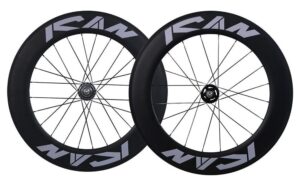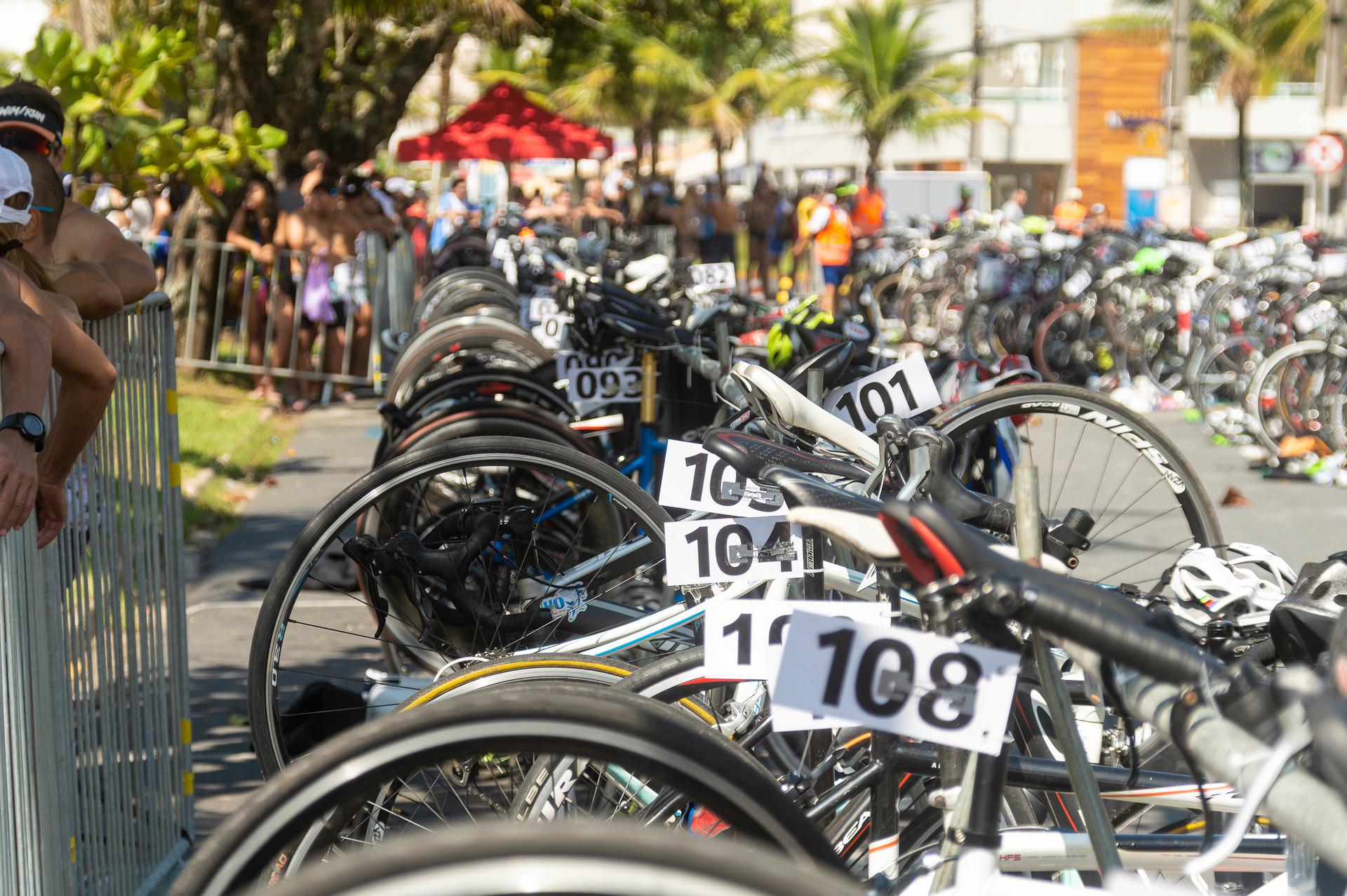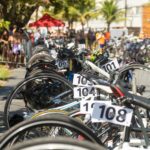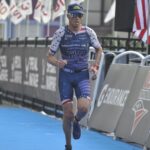I think it’s unfair to call triathlons triathlons. By its very name, triathlon suggests that there are three events in the sport. However, as we all know, there are two other events that can have a big impact on where you end up in the results at the end of the day. Of course, I’m referring to transitions—T1 and T2, in triathlon parlance—which, most everyone would agree, can play a huge role in the kind of race you have. At the same time, despite its professed importance, transitions are almost universally neglected or undervalued when it comes to time devoted to perfecting them. I experience both schadenfreude and empathy when I see pro triathletes screw up their transitions, whether dropping their helmet (hello Frodo in the Battle Royale!), stumbling (or crashing) on their flying mounts, doing a face plant on their flying dismounts, taking forever to put their running shoes on, or forgetting their race belt and having to go back for it, just to name a few of the most common fails that even the world’s best triathletes experience in T1 and T2.
 I can speak firsthand to the tragedy and glory of transitions in my first month of racing this year. First the tragedy. In my first race of the season, a Sprint distance near Sacramento, I made three major mistakes that cost me up to 45 seconds in the two transitions. In T1, I was a total “newb” trying get my wetsuit off. Then, as I left T1, I slipped doing a flying mount (yes, they are risky!) and came crashing to the ground. Not only did I drop my chain and knock my fork out of alignment, but I also hyperextended and bruised my left knee. Not to mention the embarrassment of making a tri-ass of myself! Then, leaving T2, I dropped my sunglasses, gel, and number belt, necessitating a stop, reversal, pick-up, and return to exiting the transition area.
I can speak firsthand to the tragedy and glory of transitions in my first month of racing this year. First the tragedy. In my first race of the season, a Sprint distance near Sacramento, I made three major mistakes that cost me up to 45 seconds in the two transitions. In T1, I was a total “newb” trying get my wetsuit off. Then, as I left T1, I slipped doing a flying mount (yes, they are risky!) and came crashing to the ground. Not only did I drop my chain and knock my fork out of alignment, but I also hyperextended and bruised my left knee. Not to mention the embarrassment of making a tri-ass of myself! Then, leaving T2, I dropped my sunglasses, gel, and number belt, necessitating a stop, reversal, pick-up, and return to exiting the transition area.
More painfully, in the Super Sprint at the USA Triathlon Multisport National Championships in TX two weeks ago, my bike fell off the rack in T2 due to wind and was unsure whether I would be penalized if I left it on the ground. I decided not to chance it, so I spent five seconds re-racking it. After the race, I was pleased to have finished 7th, but also frustrated that I was only two seconds behind 6th place and only 28 seconds out of 3rd place.
Now for the glory. Thanks to a USAT clinic I attended the two days before the TX event conducted by Coach Stephanie Grasky, I practiced my transitions a bunch leading up to the race series. I got a lot of reps putting my shoes on, taking my helmet on and off, and running through the transition area. I also had the chance to better understand and practice my flying mount (more like a slow-rolling, rather than a flying, mount, but much faster than stopping, stepping over the top tube, clicking a shoe into a pedal, and pushing off). I also watched several YouTube videos on how to take my wetsuit off faster. Gratifyingly, except for the fallen bike, I nailed all of my transitions and was in the mix with the fastest guys in my age. Especially pleasing was that I wore my wetsuit for the Mixed Relay event (250m swim) when most people didn’t and I was able to get my wetsuit off in less than ten seconds, thus notching a big net gain with being much faster in the swim than without a wetsuit. I also noticed that, in watching how fast the young guys are, it’s mainly because they run in and out of transition faster than I do, not that they are that much faster in the actual change process at the bike racks, that makes their transitions so much faster than mine.
Coach Stephanie Grasky, I practiced my transitions a bunch leading up to the race series. I got a lot of reps putting my shoes on, taking my helmet on and off, and running through the transition area. I also had the chance to better understand and practice my flying mount (more like a slow-rolling, rather than a flying, mount, but much faster than stopping, stepping over the top tube, clicking a shoe into a pedal, and pushing off). I also watched several YouTube videos on how to take my wetsuit off faster. Gratifyingly, except for the fallen bike, I nailed all of my transitions and was in the mix with the fastest guys in my age. Especially pleasing was that I wore my wetsuit for the Mixed Relay event (250m swim) when most people didn’t and I was able to get my wetsuit off in less than ten seconds, thus notching a big net gain with being much faster in the swim than without a wetsuit. I also noticed that, in watching how fast the young guys are, it’s mainly because they run in and out of transition faster than I do, not that they are that much faster in the actual change process at the bike racks, that makes their transitions so much faster than mine.
Okay, so it’s not revolutionary to hear that practice will make your transitions faster and problem-free. But let’s be realistic. How often are we going to take the time out of our day to actually set up a transition area and actually practice our transitions? Based on a recent survey I conducted among TeamUSA members, the consensus appears to be Never to Rarely (and, aside from the bike clinic, I was firmly in the Rarely category).
Clearly, there’s a major disconnect here given the professed importance of transitions. So, I would like to share with you some tips that might help you nail your transitions while also not requiring a lot of time, bandwidth, or energy.
KISS Principle
 I have to admit that I violated the KISS Principle (Keep it Simple, Smart!) before my races in Texas. Race rules didn’t allow matts, towels, folding seats, buckets, or balloons (I never used a bucket, folding seat, or balloons!), just what you would be using in the race, meaning bike, helmet, bike shoes, running shoes, and number belt. Wow, what a great lesson that I should have already known: The fewer things in your transition area, the less uncertainty and confusion there will be and the easier and more calmly you can complete your transitions.
I have to admit that I violated the KISS Principle (Keep it Simple, Smart!) before my races in Texas. Race rules didn’t allow matts, towels, folding seats, buckets, or balloons (I never used a bucket, folding seat, or balloons!), just what you would be using in the race, meaning bike, helmet, bike shoes, running shoes, and number belt. Wow, what a great lesson that I should have already known: The fewer things in your transition area, the less uncertainty and confusion there will be and the easier and more calmly you can complete your transitions.
So, people, reduce your “tri-stuff” in your transitions to the bare minimum. Less clutter, more clarity, smoother transitions!
Create a Routine
Perhaps it seems obvious, but, having watched a lot of triathlons, I see many competitors who don’t seem to have a particular method to their transition madness. Rather, they just arrive at their bike and reach for whatever is within easy reach. This randomness is a recipe for disaster.
to have a particular method to their transition madness. Rather, they just arrive at their bike and reach for whatever is within easy reach. This randomness is a recipe for disaster.
Fast transitions are a deliberate process and a skill that takes practice. Ideally, you don’t want to have to think at all during T1 or T2. Having a specific order you follow during each transition saves a lot of cognitive energy, reduces overthinking (which can lead to panic!), and keeps you calm. So, create a specific order that you will follow every time you transition.
Breathe and Focus on Approach
Getting out of the water heading into T1 or dismounting your bike heading into T2 can be really stressful and hectic. You’re often out of breath, your heart is racing, and you feel out of balance. You may be surrounded by a bunch of other triathletes trying to get through transition, so it’s also easy to be distracted by all the activity and even freak out if you get overwhelmed. In that unstable state, you are very likely to “pooch” your transitions and lose a lot of time.
 To mitigate all of these negatives, it is really helpful to, first, take control of your breathing. Simply focusing on taking slow, deep breaths as you enter and run through the transition area relaxes your body and centers your mind. It also helps you feel more in control mentally and physically. Second, shift your focus onto your upcoming transition. In your mind’s eye, walk yourself through each step you plan to take when you arrive at your transition area. This step blocks out distractions and directs your attention to what you will need to do shortly. In other words, you are running your “transition program” one more time before “hitting the Play button.”
To mitigate all of these negatives, it is really helpful to, first, take control of your breathing. Simply focusing on taking slow, deep breaths as you enter and run through the transition area relaxes your body and centers your mind. It also helps you feel more in control mentally and physically. Second, shift your focus onto your upcoming transition. In your mind’s eye, walk yourself through each step you plan to take when you arrive at your transition area. This step blocks out distractions and directs your attention to what you will need to do shortly. In other words, you are running your “transition program” one more time before “hitting the Play button.”
Don’t Rush
This is one of the toughest pieces of advice to follow because there is a natural pressure to do just that, RUSH!, because every second counts and everyone else seems to be rushing. Yet, going too fast often leads to slower, rather than faster, transitions because when you rush, your body tightens up, you’re not able to focus, and you actually lose your coordination (and anyone who has ever tried to strip off their wetsuit or put on their running shoes while rushing knows how absolutely spastic you can feel).
Imagery, Imagery, Imagery!
Mental imagery is my newly discovered “superpower” when it comes to nailing my transitions. Basically, it involves seeing and feeling yourself executing fast transitions over and over and over again. The great thing about imagining transitions is that you don’t have to set anything up and you can do it in the comfort of your bed or favorite chair (or as you’re standing next to your transition area on race morning). Because it’s hassle-free, it’s much easier to do and you’re more likely to do it.
There are two powerful benefits to using mental imagery to rehearse your transitions. First, you get to practice your T1 and T2 routines, so you can nail down both their order and flow. Second, and most importantly, as with anything, “practice makes proficient,” so all those mental reps of seeing and feeling yourself practicing your transitions ingrain in your mind and body the images and sensations of successful transitions (yes, when you do imagery of a physical skill, your motor programs are triggered, and your body learns).
practice your T1 and T2 routines, so you can nail down both their order and flow. Second, and most importantly, as with anything, “practice makes proficient,” so all those mental reps of seeing and feeling yourself practicing your transitions ingrain in your mind and body the images and sensations of successful transitions (yes, when you do imagery of a physical skill, your motor programs are triggered, and your body learns).
In the week leading up to my departure for the USAT Multisport Nationals in Texas, I imagined myself hitting my transitions at least twice a day, sometimes lying in bed at night, other times while riding my indoor trainer, and still other times while on runs. Once I arrived in Texas and saw the race venue and transition area, I really dialed in my transitions to match the actual setting (including Bike Out and Bike In, and Run Out and Run In, and bike mount and dismount) and must have imagined my transitions ten times each race day including several times just after setting up my transition (people probably thought I was taking a nap, just standing there with my eyes closed for several minutes) and then just before my races started.
As an added bonus in leveraging all that imagery has to offer in triathlon, I would also encourage you to imagine key parts of the race, for example, the swim start, your pacing on the bike, maintaining your stride on the run, and finishing the race strong.
imagine key parts of the race, for example, the swim start, your pacing on the bike, maintaining your stride on the run, and finishing the race strong.
The big takeaway with imagery is that, without investing much time and energy, you can program your transitions in your mind’s eye and ingrain them so deeply into your mind and body that when it’s “go time,” you just run what you’ve programmed and the result will be fast and mistake-free transitions, and faster and more satisfying races.







